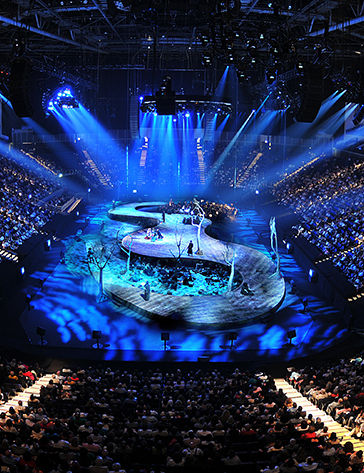Bobby Aitken is one of the UK's most notable sound designers. For the last 25 years, his company, Bobby Aitken Associates, has been designing leading theatre productions across the globe, from London's West End to the bright lights of Broadway. He gives Headliner an insight into his world...
"What’s great about my job is, I still enjoy what I do,” smiles Bobby Aitken, a softly-spoken Scot, whose sound design credits include Mamma Mia!, Dirty Dancing, Grease, and the much-talked-about Ghost. “It works quite differently in my business than it does in concerts. I’ll quite happily stand behind the console for two to three days, just with the band, and set their mixes; then the operators come in, set their recalls, and they inevitably have their input, as things change all the time.”
Aitken, who now resides in London, says it’s a blessing in itself to be able to afford to live happily in the capital with a wife and kids, and still work in music for all this time. He started out as a mixer, but it was a move down south to England where he started visualising the potential of working in the theatre industry.
“The actual tag ‘sound designer’ wasn’t really coined until the mid ‘80s. I’d been working in TV back home for a couple of years, then I moved to the Belgrade Theatre in Coventry. At this time, I felt theatre was the way forward,” he says. “In those days, very few regional theatres had a sound department... I think I was officially an ‘assistant electrician with responsibility to sound’. [laughs] In those days, it was Trident Fleximix consoles and Revox A77s, and it was great fun; lots to learn, lots of fun, and lots of beer!”
Making Waves
Aitken came to London in his mid 20s, and spent a couple of years working freelance. He then went to leading theatre sound provider, Autograph Sound, where he spent 15 years designing shows. His reputation continued to grow, as has his current business, Bobby Aitken Associates... He designed the sound for the opening and closing ceremonies at the 2012 Olympic and Paralympic Games, and he has just returned from the Sochi Winter Games, where he served as the event’s audio consultant.
“The Association of Sound Designers’ website currently lists about 100 designers. Of that, I know about a dozen or so. In this industry, the jobs tend to get broken down a bit more, so I’ll get booked if there is a lot of music in a show, generally, whereas others might get noticed if it’s a play with lots of sound effects,” he explains. “The Olympics was pretty massive, of course, but it was lots of fun. It was also very pressurised, and because it’s a different environment to theatre, it felt pretty corporate, as everything was done ‘by committee’.
It's All About The People
With regard to consoles, much like tour sound, the whole game has changed in the last 10 years. Aitken has been a DiGiCo user since the company’s inception, and it’s not just because of the quality of product:
“There had been a few attempts to get a digital product out by manufacturers, and they’d failed, but I remember just before DiGiCo were starting up, back in the Soundtracs days, they had a digital product for broadcast, and a friend of mine was using one in a mobile. I went down to Soundtracs and said they should be adapting this; 18 months later, DiGiCo was formed, and the D5 console was available. Then, towards the end of D5’s life, the SD range arrived, and the game completely changed. What we can do now is fantastic, frankly.
“I use DiGiCo because they have been so fantastically supportive, and I’ve also invested many hours into learning and understanding the SD consoles; I can just work so quickly with the SD7. I have various go-tos in terms of kit – for example, DPA is now our standard miniature mic, I don’t even think about it anymore – but in my career, everything has been to do with personalities and people; and not just the people that work for these manufacturers, but those in my crews, too; it’s really comes down to who you want to spend time with.”
According to Aitken, the biggest difference between a theatre production and a concert sound production is the requirement for the theatre audience to maintain a personal and emotional connection with the perforer:
“The audience’s aural and visual senses can be very highly tuned, and it’s imperative that the vocal sound should always appear to emanate from the actor. When your eyes are closed, and the performer moves around the stage, you should be able to hear that image move, so you’ve always got that three-dimensional connection.”
www.digico.biz
www.dpamicrophones.com

